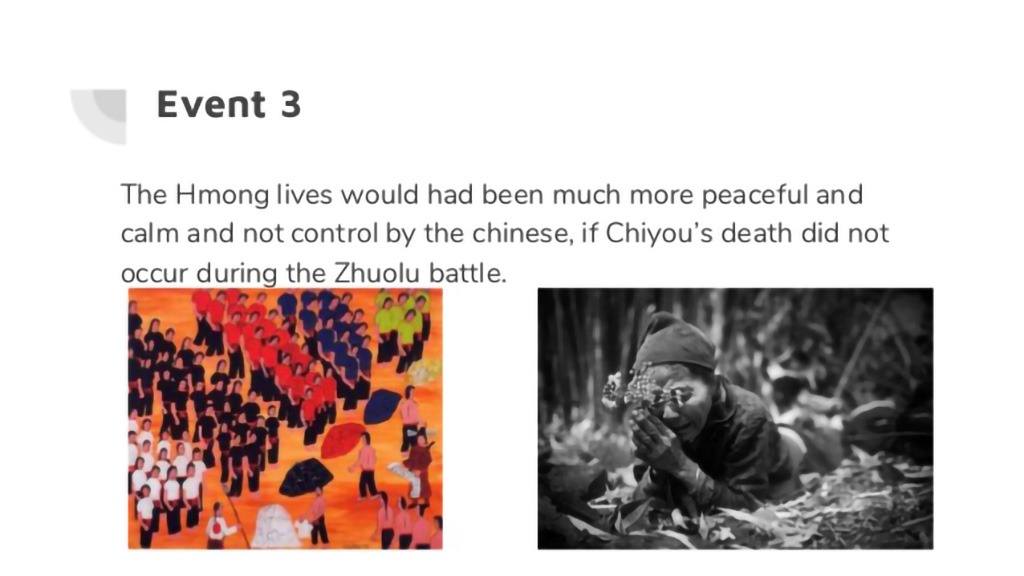
Hmong History in China

According to the Chinese, the earliest written documents of the Hmongs – Miao (a derogatory name, meaning savages, barbarians and monkey like people), as the Hmong are called in China, are found in the Chinese records. These records are focused on the Hmong’s many uprisings against the Chinese and states the Hmongs as “barbarians in need of the civilizing influences of the Chinese culture”, “They are stubborn montagnards (savages) who refuse to submit to the Chinese civilization”. The Chinese always described the Hmongs as “the attackers” and as “inferior barbarians”, and that is why the Chinese “had to punish” them. The Hmong fighters were feared throughout China and therefore leaving the Chinese to erased the majority of the Hmong history. From the Shang Dynasty (1600 – 1028 BC) to the Qing Dynasty (1644 – 1911 AD), the Hmongs and the Chinese were constantly at war with each other and eventually the Chinese pushed the Hmongs to the Southeastern corner of China.
The Chinese wanted the Hmongs to assimilate to the Chinese culture but the Hmongs did not agree. Not only did they resist in assimilation, the Hmongs aggressively fought in vengeance, starting several uprisings throughout the dynastic years. Assimilation meant that the Hmongs were under the Chinese legal and administrative control, where they were forced to pay taxes and perform unpaid labor. If the Hmongs refused any assimilation, they were beaten, killed, raped and put into slavery. Hmongs did not have the same rights and equalities of the Chinese and they were hated more and more after each succeeding dynasty.

The Chinese forced many Hmongs into a life of slavery, prohibited them from practicing the “Hmong traditions, culture and beliefs”. The Chinese destroyed the Hmong’s written language, any written documents, pottery, homes and temples, pretty much anything that they thought were of the Hmongs. They banned the Hmongs from wearing their own traditional clothing because the patterns on the clothes were coded communication for the Hmongs. The Chinese divided the Hmongs into five (5) different groups: the White Hmong, the Black Hmong, the Flowery Hmong, the Red Hmong, and the Blue Hmong. The Hmongs were ordered to wear clothing of different designs for each group, in an attempt to physically and psychologically divide them and to prevent any future unified action against the Chinese but untimely to eliminate the Hmong race. They wanted the Hmongs to forget who they are, where they came from and what language they spoke.
The Chinese did not want the Hmongs to rise up against them because they knew the Hmongs were strong warrior people. Children were not allowed to speak in Hmong and had to learn Chinese, the women were forced to marry Chinese men while Hmong men were killed or taken away into labor camps. The war between the Hmongs and the Chinese had continued for centuries because the Hmong refused to give up their culture and submit to the Chinese. The Hmongs wanted nothing more but their freedom, freedom of being slaves to the Chinese. From the 5th-10th centuries, the Hmong had become such a daunting force that the Chinese built a small-scale wall (the southern great wall) on the Hunan-Kweichow border to help ward the Hmong people off. The Hmongs wasn’t strong enough to overthrow the Chinese but they were smart and took advantage of their mountaintops, using it to ambush the unsuspecting Chinese soldiers.
Killing them by the thousands in the valley below, crushing or suffocating them by creating an avalanche effect by pushing down the big boulder rocks on top of them. There would be no survivors to tell what happened and the Chinese never knew what happened to the soldiers. Some say this could be the reason why Hmong people were called the “boogie men”. The Hmongs were also armed with only knives, spears, bows and arrows and fighting only if provoked to do so in a hand-to-hand combat. They started to pose more of a threat to the Chinese because they had learned to use their technology like how to make and use their rifles, gun-powders and cannons. The Chinese had declared war against the Hmongs and started taxing the Hmong farmers for what little they had and lost pretty much everything they owned. Over 12,000 Hmong villages were destroyed. Some women and children were fighting alongside the men, while some fled and made it to freedom. Many Hmongs were killed in the process.
The Chinese captured the Hmong rebel leader and his family and beheaded them. We can see that in both the Chinese written and the Hmong oral histories that they both agree for thousands of years the Chinese conquered the Hmongs and forced them to assimilate. The Hmongs often suffered genocide, oppression and pushed out of their own territories by the Chinese, as the Chinese population grew. This eventually pushed the Hmongs more southward into the mountains of Vietnam, Laos and Thailand, in hopes of finding peace. However, that peace they were looking for did not come.





This article was very helpful, and I really appreciate it, so thank you for spending your hard working time on this amazing article.
Hi Lauren,
Thank you! I’m glad you enjoyed the article!
This article is incredible! I enjoyed reading this til the end and I’m more interested in Hmong history. Definitely would recommend this to someone who would want to learn more of Hmong people.